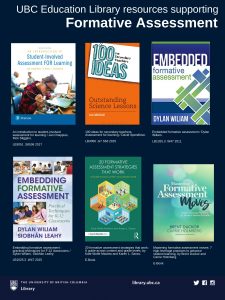Listed below are selected resources for teachers related to formative assessment.
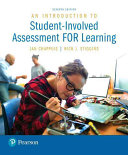 An introduction to student-involved assessment for learning
An introduction to student-involved assessment for learning
by Jan Chappuis and Richard J. Stiggins
Grades: K-12
This book is intended to help teachers establish clear learning targets as the basis for instruction and assessment, select assessment methods that align with those targets, select and/or create high-quality assessments that accurately measure student progress to the learning targets, clearly communicate assessment results to learners for both formative and summative purposes, and involve students in the assessment process to develop their capabilities to be self-directed learners.
by Dylan Wiliam
Grades: K-12
The author introduces five strategies are introduced building formative assessment into the classroom: clarifying, sharing and understanding learning intentions and success criteria; engineering discussions and activities that elicit evidence of learning; providing feedback that moves learners forward; activating students as learning resources for each other; and activating students as owners of their own learning.
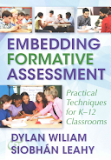 Embedding formative assessment: Practical techniques for F-12 classrooms,
Embedding formative assessment: Practical techniques for F-12 classrooms,
by Dylan Wiliam and Siobhan Leahy
Grades: K-12
Building on the five strategies for formative assessment described in Embedded formative assessment, the authors provide an overview of each strategy and a number of practical formative assessment techniques for implementing the strategies in the classroom. Along with guidance on when and how to use the specific techniques, they provide tips, cautions and enhancements to sustain formative assessment. A student reflection form, peer observation form and self-reflection checklist accompany each strategy.
 The formative assessment action plan: Practical steps to more successful teaching and learning
The formative assessment action plan: Practical steps to more successful teaching and learning
by Nancy Frey and Douglas Fisher
Grades: K-12
The book describes a four-step approach to implementing formative assessment in the classroom: ensuring that students understand the purpose of an assignment, task, or lesson, including how they will be assessed; checking for understanding to guide instruction and determine if students are making progress toward their goals; providing feedback to students; and building on that feedback to facilitate student achievement.
 Checking for understanding: Formative assessment techniques for your classroom
Checking for understanding: Formative assessment techniques for your classroom
by Douglas Fisher and Nancy Frey
Grades: K-12
The authors present five formative assessment techniques that can be used to check for understanding: oral language strategies that close the gap between what students need to know and what they already know; using writing to check for understanding in any subject; student response techniques that increase participation and engagement; projects and performances that are easily integrated into daily classroom practice; and test items that help plan further instruction.
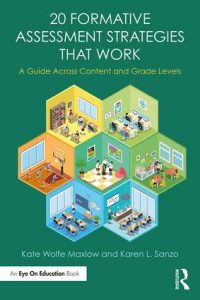 20 formative assessment strategies that work: A guide across content and grade levels
20 formative assessment strategies that work: A guide across content and grade levels
by Kate Wolfe Maxlow and Karen L. Sanzo
Grades: K-12
The authors present a range of formative assessment strategies and ways to implement them, using activities involving collaboration, movement, and/or selecting and supplying responses. (E-book)
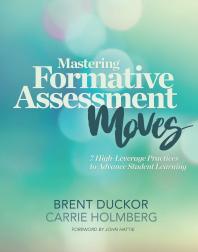 Mastering formative assessment moves: 7 high-leverage practices to advance student learning
Mastering formative assessment moves: 7 high-leverage practices to advance student learning
by Brent Duckor and Carrie Holmberg
Grades: K-12
The authors present seven strategies that can be used as part of formative assessment: priming (building on background knowledge), posing (asking questions), pausing (waiting after questions), probing (deepening discussions), bouncing (sampling student responses), tagging (recording student responses), and binning (interpreting student responses). (E-book)
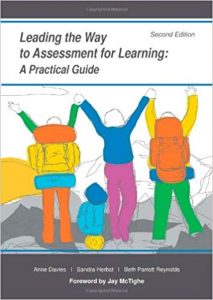 Leading the way to assessment for learning: A practical guide
Leading the way to assessment for learning: A practical guide
by Anne Davies, Sandra Herbst, and Beth Parrott Reynolds
Grades: K-12
This book presents a number of strategies for formative assessment, including describing success, beginning with the end in mind, involving students in instruction, and using assessment to guide instruction.
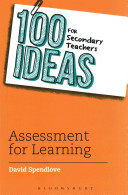 100 ideas for secondary teachers: Assessment for learning
100 ideas for secondary teachers: Assessment for learning
by David Spendlove
Grades: 9-12
The author suggests that assessment for learning (AfL) can help to increase student autonomy and ensure progress is taking place for every student. Key topics covered are questioning and dialogue, written and verbal feedback, and improving behaviour using AfL strategies and explaining its importance to parents.
 Formative classroom assessment: Theory into practice
Formative classroom assessment: Theory into practice
edited by James H. McMillan
Grades: K-12
The essays in this book present a state-of-the-art review of formative assessment in the classroom. Experts examine what is currently known about formative assessment and its application to teaching, balancing theory and research with practical applications.
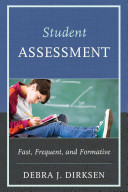 Student assessment: Fast, frequent, and formative
Student assessment: Fast, frequent, and formative
by Debra J. Dirksen
Grades: K-12
Just as video games often have a ‘reset button’, this book suggests that formative assessment can be used in the classroom as a virtual ‘reset button’ for student learning. A range of formative assessment strategies and techniques are discussed, such as the use of graphic organizers, quick writes, and journaling.
Finding More Resources
To find more resources in this area, try the following:
- Search using the General tab on the UBC Library website to look for material in all UBC Library branches.
- Search using “Search Education Resources” box in the left-hand bar on the Education Library website to limit your results to physical materials in the Education Library.
- Use specific search terms, such as “formative assessment”, “formative assessment techniques”, or “educational tests and measurements”.
- To find lesson plans, include “lesson plans”, “lesson planning”, or “activity programs” in your search terms.
For more help with searching, please visit the Library Service Desk or e-mail ed.lib@ubc.ca.

